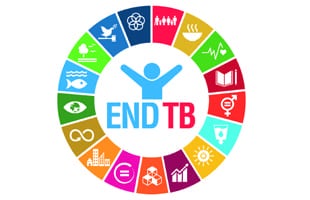Tuberculosis (TB) is a disease of, above all, the people whom society has marginalized. Certainly everyone is at risk, and some who are not at the margins of society – health workers, for example – are among those at heightened risk. Yet the risk of contracting and dying from the disease is greatest among an array of key populations, overwhelmingly defined by markers of marginalization – people living in poverty, indigenous peoples, migrants, people with HIV and AIDS, and people confined to prison, among others. Earlier this week, the United Nations convened a High-Level Meeting on TB. The very fact of the meeting is evidence that the political will to tackle TB is growing – though as country realities continue to bear out, it is still deeply insufficient.

Image courtesy of WHO.
Indications of political will to tackle a disease concentrated among marginalized populations raise deeper questions: Is there political will to confront the conditions driving marginalized population’s heightened vulnerability to TB – the underlying conditions driving marginalization themselves? Is there political will to earnestly address health inequity and its drivers?
The Sustainable Development Goals sought to put the commitment to leave no one behind at the center of development and health policymaking. If that commitment is to be more than just words – and to WHO’s credit, it is developing an expanding toolkit to assist countries in this effort (such this report on health inequity) – countries should develop comprehensive health equity programs of action, an approach that could also powerfully amplify present efforts to end TB.

Image courtesy of Oxfam.
Health equity programs of action would be systematic approaches to deciding on and acting upon measures required to narrow – and ultimately end – health inequities within countries, developed through national leadership and inclusive, empowering approaches, identifying specific actions and targets, backed with robust accountability. They would follow seven principles, and could be incorporated into national health plans or national development strategies, though separately developed health equity programs of action are another option. The principles could also be applied to national TB strategies or other disease strategies, as well as being the foundation for municipal or other sub-national efforts to address health inequity.
The seven principles are:
- Empowering Participation & Inclusive Leadership, with people from marginalized and disadvantaged populations part of the leadership for all processes and accountability mechanisms related to these programs of action.
- Maximizing Health Equity, moving as quickly and completely as possible towards full health equity, requiring addressing a broad array of health issues, along with structural determinants of health inequities, such as systemic discrimination, political exclusion, and control over resources.
- Health Systems and Beyond: All Social Determinants of Health, addressing all social, environmental, structural, and commercial determinants of health and adopting intersectoral approaches.
- Every Population Counts, systematically address each population facing health inequities, responding both to factors driving health inequities shared by many populations and to those particular to only one or several populations.
- Actions, Targets, and Timelines, with specific actions linked to timelines for carrying them out and measurable targets, as actions are integrated into each sector’s plans.
- Accountability, with both government-led and independent monitoring and evaluation, along with ongoing inclusive structures for and approaches to accountability, like national health equity dialogues, while strengthening health accountability mechanisms at national and sub-national levels.
- High-Level Political Commitment, as sustained high-level political leadership is needed for successful implementation, resource mobilization, intersectoral approaches, and long-term efforts towards ending health inequities.
Health equity programs of action would augment other efforts to end TB in a number of ways:
- Bringing communities affected by TB to the center of the TB response: Unlike people living with HIV and AIDS, people affected by TB are not routinely involved in planning and implementing TB prevention and treatment efforts. Yet the communities that are at heightened risk of TB would be central to decision-making processes for developing programs of action.
- Addressing health risks that increase vulnerability to TB: Health threats other than TB increase people’s risk of TB, including diabetes and smoking. Without addressing the higher risks that marginalized populations face in these areas, the TB response will be missing important elements. Health equity programs of action would address these risks.
- Acting on root causes of vulnerability to TB: While such root causes as inadequate housing, malnutrition, overcrowding in prisons, discrimination against migrants, high poverty and low employment among indigenous populations, and so forth, may be addressed at the edges in national TB strategies, such strategies are not designed to transform such significant issues in and of themselves. By contrast, addressing these factors head-on would be central to health equity programs of action.
- Leaving no TB key population behind: National TB strategies do not always include all key populations. For example, migrants are not a key population in South Africa’s National Strategic Plan for HIV, TB and STIs 2017-2022, despite considerable migration into South Africa from nearby countries, which like South Africa have high levels of TB. While many migrants at heightened risk of TB are miners, and the strategic plan does list miners as a key population, not all migrants are miners. And not addressing migrants as such will miss key elements of realities particular to migrants, including ensuring continuity of care if they leave South Africa while they have TB.
- Accountability at every level: Top-quality national TB strategies and health plans are more desirable than poor quality strategies and plans. Good laws and policies are desirable. Yet unless these are robustly implemented, their impact will be limited. Accountability is vital. Health equity programs of action would establish a comprehensive regime of health accountability. This would include accountability to the programs of action themselves – such as through government and independent monitoring and evaluation (for example, through joint external evaluations and multi-stakeholder bodies that include governments, civil society, and members of marginalized and disadvantaged populations), and national health equity dialogues where policymakers are directly answerable to members of the public. Accountability would also include more general health accountability policies and processes, as diverse as public human rights education, operational village health committees, parliamentary hearings on the right to health, and enhanced access to justice.
The Sustainable Development Goals promised that no one would be left behind. TB puts this pledge to the test. Health equity programs of action would be a powerful statement of countries’ commitment to passing this test, with its life and death implications for many millions and implications for the health and well-being of billions.



